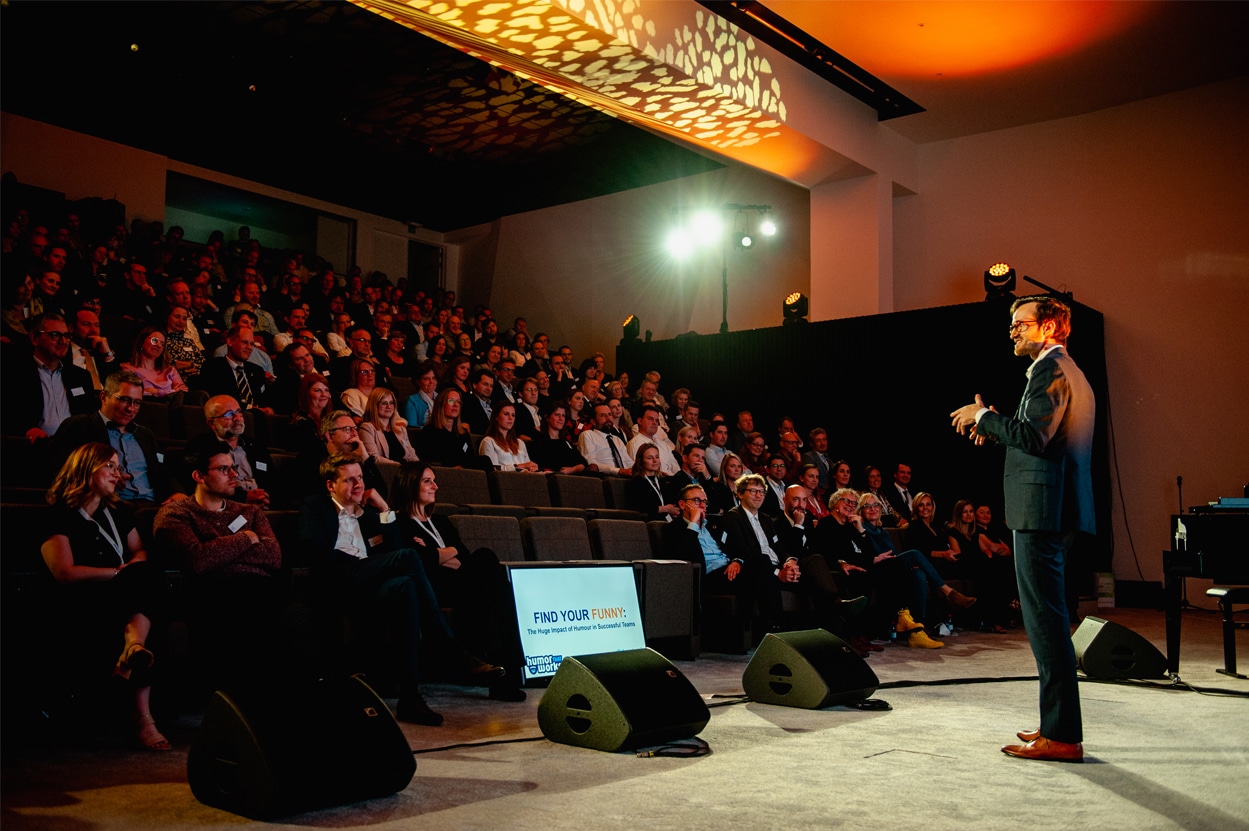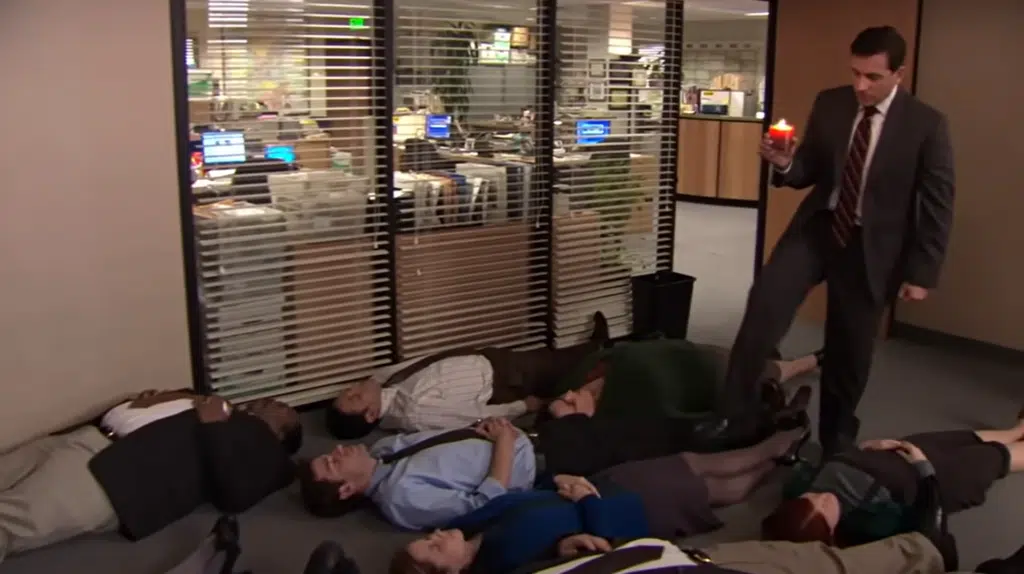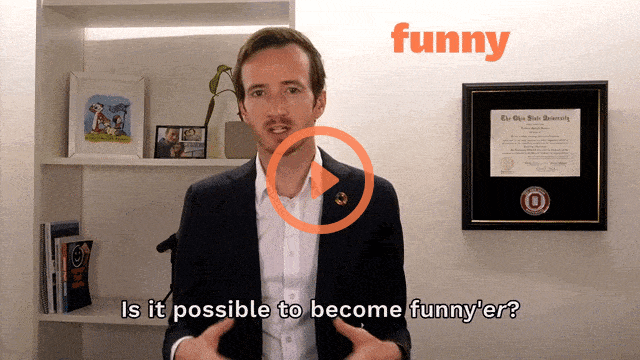"Tonight, we are going to laugh. And we are going to cry... we are going to laugh at people who cry."
Michael Scott
After Dwight's extreme fire drill causes Stanley to have a heart attack, Michael Scott attempts to relieve the office's stress levels by holding a comedic roast of himself to lighten the mood and encourage laughter among his team. ("Stress Relief" episodes of "The Office" - Season 5, Episodes 14 and 15)
And because this is “The Office,” Michael proves to be unable to handle the jokes made at his expense and turns the event itself into a stressful situation, which is the exact opposite of what he was going for. He also tries various relaxation techniques, lectures on stress, enforced group hugs (because who doesn’t find forced bodily contact relaxing) among other things.
I know “The Office” is the posterchild for a boss that is trying way too hard, but it does capture how some workplace dynamics work (albeit greatly exaggerated). The motivations behind Michael’s actions aren’t too far from real life.
The same instincts that get us to laugh at this “buffoonery” also keep us from attempting humor in the workplace more. We don’t want to be Michael Scott in our own Office.

Two Emotional Extremes - Toxic Positivity vs Toxic Negativity
Amidst the drive for productivity and efficiency, the emotional spectrum within the workplace often swings wildly between two extremes: toxic positivity and toxic negativity.
TOXIC POSITIVITY
At one end of the spectrum lies toxic positivity, the excessive and compulsive focus on positive outcomes and emotions, often at the expense of genuinely acknowledging and addressing negative feelings and challenges.
You see this in more places besides “The Office.”
Sitcoms and TV shows: Ted Lasso, Brooklyn Nine-Nine, and Parks and Recreation all have examples of people who are enjoyable to watch from afar but would probably be pretty annoying to work for after long stretches of time.
Inspirational Social Media Content: motivational quotes and posts that encourage you to "just be positive" or "not let negativity bring you down” (which is then immediately followed by a social media post of negative news, trolling, or ragebait).
Self-help Books and Gurus: self-help materials and personalities advocate a version of positivity that overlooks the validity of negative emotions, with mindsets such as: “you just gotta stay positive” or “everything happens for a reason!”
Commercials: Advertisements often promote products by associating them with an idealized, always-happy lifestyle, suggesting that purchasing certain products will lead to constant joy and fulfillment. Unhappy? You just need a bit of McDonald’s with a side of Coca-Cola (and possibly diabetes).
And listen, I LOVE Ted Lasso. The show is incredibly nuanced and doesn’t gloss over things like panic attacks, toxic masculinity, and how hard it is to be positive in the face of negativity. But, let’s be honest, if Ted were your coworker, he could be a bit much.
These narratives can overshadow the struggles, setbacks, and negative emotions, promoting a simplified view of success and happiness. And while the intention behind these messages is often to motivate, they can inadvertently suggest that if you're not successful or happy, it's simply because you're not thinking positively enough.
Most people’s idea of humor in the workplace is scenarios similar to The Office and Ted Lasso. That it’s one person using humor just so people will like them. That’s not how it actually works in the real world. At least not in the way we approach it at Humor That Works.
When the FBI had brought me in to teach their agents about humor in the workplace, the end goal was not to have a successful roast (of the FBI director or possible criminal suspects). Rather, they wanted me to help their agents build better rapport with people (and manage the stress of their very intense job)… and that’s what we did.

TOXIC NEGATIVITY
Conversely, toxic negativity dominates the other end of the spectrum.
You’ll find it in environments saturated with pessimism, where complaints and criticisms overshadow positivity and constructive feedback. In my experience, toxic negativity not only feels crappy, it stifles innovation and growth, creating a cycle of discontent and disengagement.
Similarly, it is largely promoted in the media and the news where there’s a new reason for conflict at every turn.
Somewhat ironically, toxic negativity is seen as more appropriate than toxic positivity. As if to say - “It’s ok if you’re cynical, as long as you’re not too happy.” What a sinister message this conveys about our society.
The effects of lingering in either extreme are profound.
Toxic positivity often leads to a culture of denial, where problems are glossed over, and employees feel pressured to mask their true feelings, leading to increased stress and burnout. Meanwhile, toxic negativity can erode morale, reducing motivation and productivity, and making the workplace an environment of dread rather than aspiration.
But these are extremes for a reason - despite common assumptions, they rarely happen. In the 10+ years since I’ve teaching people about humor in the workplace, I have met exactly 0 Michael Scotts. Sure there are people who do try a bit too hard, but not to the point you could create 9 seasons about it.
And yet we act as if using humor at work is the gateway drug to becoming the office clown.
In reality, there is a very thick and gray line between toxic positivity and toxic negativity (the kind you can't even jump over.)
Introducing…
THE EMOTIONAL GOLDILOCKS ZONE
The Emotional Goldilocks Zone is where you’re allowed to laugh, not because sadness is forbidden, but because joy and sadness are sides of the same coin - something a good team leader knows well.
This is achieved when an organization recognizes and validates the full spectrum of human emotions, creating a supportive environment that allows employees to express genuine feelings and concerns.
This balance is crucial for fostering psychological safety, where everyone feels valued and understood, leading to higher engagement, creativity, and productivity.
And while it’s generally within a team leader’s responsibilities to make efforts to nurture emotionally intelligent behaviors and instill policies that support mental health and well-being, your happiness is still very much within your control.
Even if your office environment leans over the negative side, you can take it upon yourself to improve your own bubble, and when you feel safe and able, improve your colleague’s bubble until the office culture changes (or you find another job).
Just maybe avoid trying to do a roast as your chosen form of stress relief.




